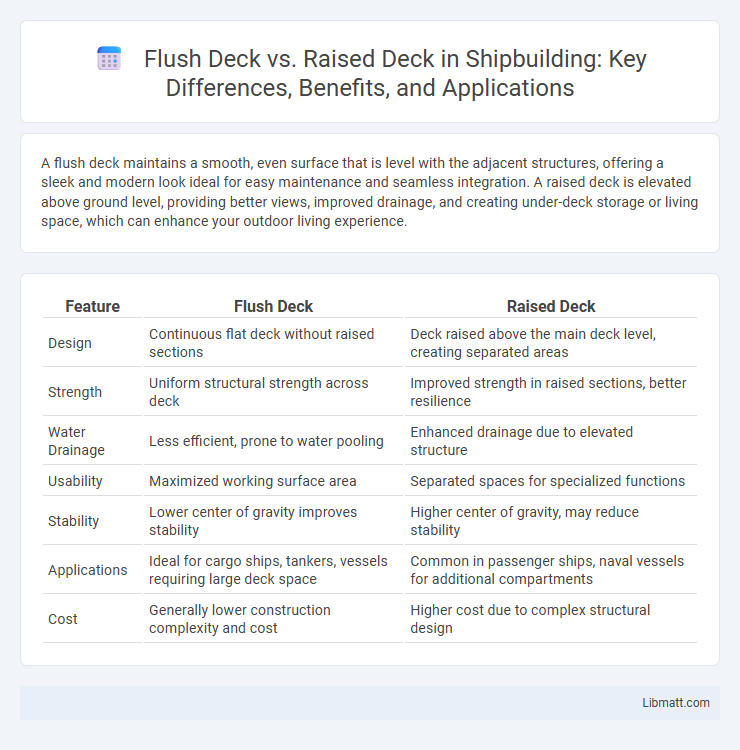A flush deck maintains a smooth, even surface that is level with the adjacent structures, offering a sleek and modern look ideal for easy maintenance and seamless integration. A raised deck is elevated above ground level, providing better views, improved drainage, and creating under-deck storage or living space, which can enhance your outdoor living experience.
Table of Comparison
| Feature | Flush Deck | Raised Deck |
|---|---|---|
| Design | Continuous flat deck without raised sections | Deck raised above the main deck level, creating separated areas |
| Strength | Uniform structural strength across deck | Improved strength in raised sections, better resilience |
| Water Drainage | Less efficient, prone to water pooling | Enhanced drainage due to elevated structure |
| Usability | Maximized working surface area | Separated spaces for specialized functions |
| Stability | Lower center of gravity improves stability | Higher center of gravity, may reduce stability |
| Applications | Ideal for cargo ships, tankers, vessels requiring large deck space | Common in passenger ships, naval vessels for additional compartments |
| Cost | Generally lower construction complexity and cost | Higher cost due to complex structural design |
Introduction to Flush Decks and Raised Decks
Flush decks feature a flat surface level with the hull edge, providing a sleek, streamlined appearance ideal for modern yacht designs and maximizing usable deck space. Raised decks elevate the deck above the hull, creating additional interior volume and enhancing water drainage, commonly favored in cruising sailboats and fishing vessels for improved comfort and functionality. Both deck types impact vessel performance and aesthetics, with flush decks offering a minimalist profile and raised decks delivering increased headroom below deck.
Key Differences Between Flush and Raised Deck Designs
Flush deck designs feature a smooth, continuous surface that aligns with the vessel's hull, offering sleek aesthetics and easier deck movement. Raised deck designs elevate portions of the deck above the main hull line, creating additional interior space and improved water drainage. Key differences lie in spatial utilization, deck height, and water runoff management, with flush decks emphasizing streamlined profiles and raised decks enhancing cabin volume and dryness.
Structural Integrity: Flush Deck vs Raised Deck
Flush decks offer enhanced structural integrity by maintaining a continuous surface that evenly distributes stress and load, reducing potential weak points. Raised decks, while aesthetically appealing and providing additional headroom, introduce seams and joints that may require reinforced framing to prevent structural weaknesses. Your choice between flush deck and raised deck should consider the balance between desired design features and the level of structural robustness needed for your project.
Aesthetic Appeal: Comparing Deck Styles
Flush decks offer a sleek, seamless aesthetic that integrates smoothly with your home's exterior, creating a modern and minimalist look. Raised decks provide enhanced visual interest and architectural dimension, often becoming a focal point that elevates the outdoor space's character. Your choice between flush deck and raised deck styles will significantly impact the overall curb appeal and harmony of your outdoor environment.
Space Utilization and Layout Efficiency
Flush decks maximize usable space by providing a continuous, unobstructed surface, enhancing layout efficiency for furniture placement and movement. Raised decks offer segmented areas with elevation changes that create distinct zones but may reduce overall contiguous space. Efficient space utilization depends on the intended activities, with flush decks favoring flexibility and raised decks promoting spatial differentiation.
Maintenance and Longevity Factors
Flush decks feature a streamlined surface that minimizes water pooling, reducing the risk of rot and simplifying routine cleaning, which enhances maintenance efficiency and longevity. Raised decks offer better ventilation underneath, helping to prevent moisture buildup and structural decay, but may require more frequent inspections to address potential pest intrusion and weather exposure. Selecting the appropriate deck type depends on environmental conditions, material choice, and desired maintenance commitment to maximize durability and lifespan.
Safety and Accessibility Considerations
Flush decks provide a smooth, level surface that minimizes tripping hazards and enhances safety by reducing uneven steps. Raised decks elevate the platform, requiring stairs or ramps that must meet accessibility standards to ensure safe and easy access for all users. You should assess your space and user needs carefully to choose between the streamlined safety of a flush deck or the versatile height options of a raised deck.
Suitability for Different Vessel Types
Flush decks are ideal for smaller, high-speed vessels such as patrol boats and fishing craft, offering a continuous, unobstructed deck surface that enhances stability and ease of movement. Raised decks suit larger ships like cargo and passenger vessels by providing additional below-deck space for machinery, storage, or accommodations without compromising overall vessel height. The choice between flush and raised decks depends on the vessel's operational requirements, balancing factors like cargo capacity, crew comfort, and navigational visibility.
Cost Implications of Deck Designs
Flush deck designs typically offer lower construction costs due to simpler framing and uniform rooflines, reducing labor and material expenses. Raised deck structures often require additional support beams, complex engineering, and extended roofing, leading to higher initial investment and increased maintenance costs. Homeowners should weigh budget constraints against aesthetic and functional preferences when choosing between flush and raised deck options.
Choosing the Right Deck: Factors to Consider
Flush decks offer a sleek, modern look with surfaces level to the boat's hull, ideal for maximizing space and ease of movement. Raised decks provide better interior headroom and additional storage, enhancing comfort for extended trips. When choosing your deck type, consider your boating activities, desired aesthetic, and the balance between exterior functionality and interior space.
Flush deck vs raised deck Infographic

 libmatt.com
libmatt.com